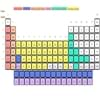Meitnerium Silver Comparison
Periodic Table
Symbol
Mt
Ag
Group Number
9
9
11
7
Period Number
7
5
Block
d block
d block
Element Family
Probably Transition
Transition Metal
CAS Number
54038016
10
7440224
99+
Space Group Name
Not Available
Fm_ 3m
Space Group Number
Not Available
225.00
2
Facts
Interesting Facts
Not Available
- It is the most reflective element.
- Silver is the second most ductile metal after Gold.
- It is also used in Dentistry as a dental alloys for clips and crowning.
Sources
Bombarding Bi209 with Accelerated Nuclei of Fe58, Synthetically Produced
Earth's crust, Found in Minerals, Ores of metals
History
Who Discovered
Gesellschaft für Schwerionenforschung
Unknown
Discovery
In 1982
Before 5000 BC
Abundance
Abundance In Universe
Not Available
6 * 10-8 %
26
Abundance In Sun
~-9999 %
~0.0000001 %
26
Abundance In Meteorites
Not Available
0.00 %
38
Abundance In Earth's Crust
Not Available
0.00 %
99+
Abundance In Oceans
Not Available
0.00 %
19
Uses
Uses & Benefits
- Currently known uses of Meitnerium metal are limited to research purpose only.
- Silver is mainly used for Jewelry and show piece.
- It is used for manufacturing high quality mirrors due to its reflectivity property.
Industrial Uses
NA
Chemical Industry, Clothing Industry, Electrical Industry
Medical Uses
NA
Dentistry, Pharmaceutical Industry
Other Uses
NA
Alloys, Bullion, Coinage, Jewellery, Sculptures, Statues
Biological Properties
Toxicity
Unknown
Non Toxic
Present in Human Body
No
Yes
In Blood
0.00 Blood/mg dm-3
37
0.00 Blood/mg dm-3
29
In Bone
0.00 p.p.m.
36
0.44 p.p.m.
20
Physical Properties
Melting Point
Not Available
961.93 °C
99+
Boiling Point
Not Available
2,212.00 °C
99+
Appearance
Physical State
Solid
Solid
Color
Unknown
Silvery White
Luster
Unknown Luster
Metallic
Hardness
Mohs Hardness
Not Available
2.50
14
Brinell Hardness
Not Available
251.00 MPa
37
Vickers Hardness
Not Available
229.00 MPa
30
Speed of Sound
Not Available
2,680.00 m/s
34
Optical Properties
Reflectivity
Not Available
97.00 %
1
Allotropes
No
No
α Allotropes
Not Available
Not Available
β Allotropes
Not Available
Not Available
γ Allotropes
Not Available
Not Available
Chemical Properties
Chemical Formula
Mt
Ag
Isotopes
Known Isotopes
4
33
36
3
Electronegativity
Pauling Electronegativity
Not Available
1.93
9
Sanderson Electronegativity
Not Available
1.83
11
Allred Rochow Electronegativity
Not Available
1.42
18
Mulliken-Jaffe Electronegativity
Not Available
1.47
15
Allen Electronegativity
Not Available
1.87
7
Electropositivity
Pauling Electropositivity
Not Available
2.07
99+
Ionization Energies
1st Energy Level
800.80 kJ/mol
15
731.00 kJ/mol
27
2nd Energy Level
1,823.60 kJ/mol
17
2,070.00 kJ/mol
11
3rd Energy Level
2,904.20 kJ/mol
31
3,361.00 kJ/mol
19
4th Energy Level
3,859.40 kJ/mol
99+
Not Available
5th Energy Level
4,920.80 kJ/mol
35
Not Available
Electrochemical Equivalent
Not Available
4.02 g/amp-hr
7
Electron Work Function
Not Available
4.26 eV
20
Other Chemical Properties
Ionization, Radioactive Isotopes, Radioactivity
Chemical Stability, Ionization, Solubility
Atomic Properties
Atomic Number
109
9
47
99+
Electron Configuration
[Rn] 5f14 6d7 7s2
[Kr] 4d10 5s1
Crystal Structure
Face Centered Cubic (FCC)
Face Centered Cubic (FCC)
Crystal Lattice
FCC-Crystal-Structure-of-Meitnerium.jpg#100
FCC-Crystal-Structure-of-Silver.jpg#100
Atom
Number of Protons
109
9
47
99+
Number of Neutrons
157
7
61
99+
Number of Electrons
109
9
47
99+
Radius of an Atom
Atomic Radius
122.00 pm
99+
144.00 pm
36
Covalent Radius
129.00 pm
99+
145.00 pm
39
Van der Waals Radius
Not Available
172.00 pm
38
Atomic Weight
278.00 amu
7
107.87 amu
99+
Atomic Volume
Not Available
10.30 cm3/mol
99+
Adjacent Atomic Numbers
Valence Electron Potential
Not Available
11.40 (-eV)
99+
Lattice Constant
Not Available
408.53 pm
20
Lattice Angles
NA
π/2, π/2, π/2
Lattice C/A Ratio
Not Available
Not Available
Mechanical Properties
Density
Density At Room Temperature
37.40 g/cm3
2
10.49 g/cm3
35
Density When Liquid (at m.p.)
Not Available
9.32 g/cm3
21
Tensile Strength
Not Available
Not Available
Viscosity
Not Available
Not Available
Vapor Pressure
Vapor Pressure at 1000 K
Not Available
0.00 (Pa)
14
Elasticity properties
Shear Modulus
Not Available
30.00 GPa
23
Bulk Modulus
Not Available
100.00 GPa
16
Young's Modulus
Not Available
83.00 GPa
23
Poisson Ratio
Not Available
0.37
7
Other Mechanical Properties
NA
Ductile, Malleable
Magnetic Properties
Magnetic Characteristics
Specific Gravity
Not Available
10.50
26
Magnetic Ordering
Paramagnetic
Diamagnetic
Susceptibility
Not Available
0.00
5
Electrical Properties
Electrical Property
Unknown
Conductor
Resistivity
Not Available
15.87 nΩ·m
99+
Electrical Conductivity
Not Available
0.63 106/cm Ω
1
Electron Affinity
Not Available
125.60 kJ/mol
5
Thermal Properties
Specific Heat
Not Available
0.24 J/(kg K)
25
Molar Heat Capacity
Not Available
25.35 J/mol·K
99+
Thermal Conductivity
Not Available
429.00 W/m·K
1
Critical Temperature
Not Available
Not Available
Thermal Expansion
Not Available
18.90 µm/(m·K)
23
Enthalpy
Enthalpy of Vaporization
Not Available
255.10 kJ/mol
37
Enthalpy of Fusion
Not Available
11.30 kJ/mol
31
Enthalpy of Atomization
Not Available
284.50 kJ/mol
37
Standard Molar Entropy
Not Available
42.60 J/mol.K
35
|
||
|
||
|












